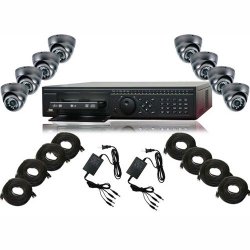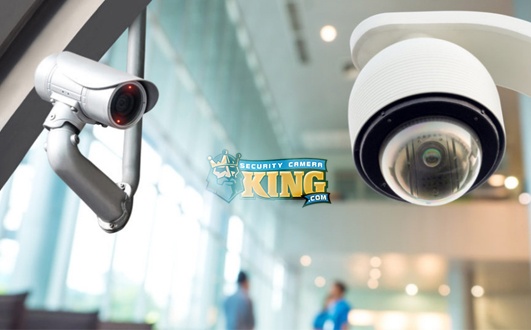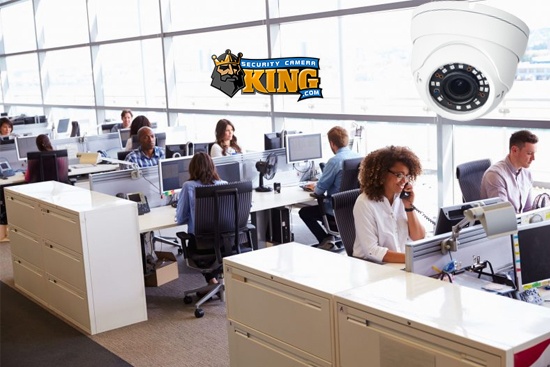 Security systems with 8 cameras can fulfill many of your security and surveillance needs. Many business and residential applications alike can provide complete outdoor/indoor surveillance by using security systems with 8 cameras. In addition, modern technology has yielded systems that are incredibly versatile such that they can be used for nearly every type of application.
Security systems with 8 cameras can fulfill many of your security and surveillance needs. Many business and residential applications alike can provide complete outdoor/indoor surveillance by using security systems with 8 cameras. In addition, modern technology has yielded systems that are incredibly versatile such that they can be used for nearly every type of application.
A basic security system with 8 cameras consists of the 8 cameras, a processor digital video recorder or DVR unit with a CODEC application, and a monitor. The cameras are placed in their appropriate locations to provide the maximum coverage necessary to fulfill the security requirements for the system. A coaxial cable is run from each camera to the processor/DVR unit. Each camera has a small wire run from either a wall adapter or power distribution center to provide it with the electricity necessary to function.
The processor/DVR and monitor may be placed in a different location. For example, a retail store may have two cameras that cover the external perimeter of the store, five cameras inside the store, and one camera covering the cashier’s desk. The processing unit/DVR and monitor however, are located in the store’s office, away from public view. This provides a remote, usually more secure area for monitoring and recording the video from the cameras.
Security systems with 8 cameras are often referred to as “8 channel” systems. This basically means that the processor/DVR has the ability to receive 8 different inputs, usually simultaneously. In fact the processor/DVR is usually referred to as an 8 channel DVR and the power supply center is usually referred to as an 8 channel power distribution center.
If the coaxial transmission cable that is run from each camera to the processor/DVR is unsightly or difficult to install, there are wireless security systems with 8 cameras. These systems differ in that the cameras have their own on-board antenna which they use to transmit their video signal. The video is sent to a receiver unit using either the 2.4 or 5.8 GHz radio band technology. The receiver simply transfers the radio signal into an electrical signal and passes it on to the processor/DVR.
Since security cameras utilize the 2.4 or 5.8 GHZ band technology, their rated maximum ranges are based on Line Of Sight or LOS. An LOS range is the ideal distance between the camera and the receiver where the area between the two is not impeded by objects such that one can’t be seen from the other’s position. This does not mean that the camera and receiver must have a perfectly unimpeded LOS, however reception ranges will decrease based on the material that the transmitted radio waves must pass through.
There are several other features and options for a security system with 8 cameras. Each camera does not have to be the exact same model. Therefore, different cameras with different functions can be “mixed and matched” within the system to accommodate your security requirements. This and the fact that the system itself is basically a component system that allows a variety of different equipment features, makes the system incredibly versatile in application.
Here is a partial list of some of the many options/features available for the cameras:
- • Cameras can be indoor or outdoor types
- • Day/night vision cameras produce high quality color video in conditions with very little visible light
- • Night vision infrared cameras produce high quality monochrome video in conditions of total darkness (under normal daylight conditions these cameras produce high quality color video)
- • Audio recording
- • Pan-Tilt-Zoom features that allow the camera to move to increase its field of view or telescopically enlarge the target
- • Hidden or disguised cameras
The processor/DVR unit of a security system with 8 cameras can also have different features. The processor converts the cameras’ video signal into a digital video file. These files can be incredibly large and bulky which can make them difficult for the processor or the DVR to store. The processor/DVR uses a COmpression/DECompression or CODEC utility to reduce the size of the file while maintaining high video quality. There are several different CODECs available.
The DVR is much like the hard disk drive on a personal computer. Its size can range from a few hundred gigabytes to several terabytes. In addition DVD or CD drives may be included for archiving and copying video files.
A security system with 8 cameras can provide you with the security coverage you need and is versatile enough to be used in almost every situation.












